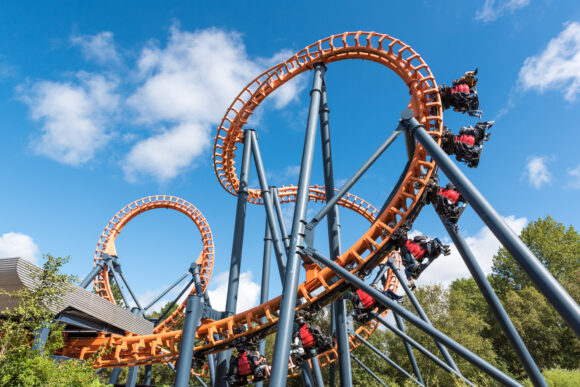One of my favorite recent additions to our Academy of Insurance catalog has been our How To Write series. We have used this series of sponsored content to highlight niche markets so agents can be exposed to what makes for a great risk in different categories. One of the niches we explored last year was the family entertainment space. If you haven’t checked out that class, visit: www.ijacademy.com to register. It won’t cost you anything but time, and we think it’s time well spent.
When you think about family entertainment risks, there’s more to consider than just the rides, lines, and shops. Today, these risks will combine all of those exposures that you think about from an amusement park 30 years ago and much more. There is an amusement park near my family that we have gone to for over 20 years, and we have watched them grow from a few rides and a nice little petting zoo into a multi-faceted entertainment space.
The Risks of Having Fun
The basic aspects of the risks include what you expect. There is a large parking lot full of cars, trucks, buses, and RVs all moving around, jockeying for the best spots, and there are no people out there directing traffic. Once you’re inside, there are crowds of people doing crowd things like running to the next ride, stopping right in front of other people who are just trying to get to the ice cream shop, kids everywhere, and all of the other fun that crowds bring. Of course, there are the shops where every person under 10 looks at their people who are over 10 and asks for the overpriced stuffed animal, t-shirt, or more food to feed the gators.
But what else is going on there?
The dining options at our park have changed over time, as they have in parks around the country. It’s not just pizza, wings, hot dogs, and burgers. There are sit-down places where you can get a proper meal. There are a few places where the adults can even have adult beverages. That adds a new layer of risk to our park. We can all agree that there are people who will have an adult beverage and that’s the end of it. Consider, however, that we’re not talking about someone having a beer in their living room. We’re talking about someone having the same beverage in an environment where the “fun” stopped happening three hours ago, the South Georgia sun has baked most of the moisture out of them, and the crowds have been extra special, so an adult beverage or two isn’t as simple as it could be.
Additionally, our park isn’t just a place for hanging out with the family on a relaxing summer day; it’s also a concert venue. We will consider some of the concerts family-friendly events. This park isn’t bringing in groups that are likely to cause a giant mosh pit to open up–although anything is possible. But we aren’t talking about concerts in the middle of the day. The concerts are normally held later in the day and run into the night, so that attendees, even families, have now spent all day enjoying the park, and by the time the concert is over, they might have spent 10-12 hours there. You can imagine the risks that this can create for the park.
None of these risk exposures are unique to this one park. Other venues have very similar exposures. They have parking lots, crowds, concerts, events, and more. Many also have resort hotels and camping sites available, adding to the risk exposures.
So far, all we’ve done is think through the process of identifying the risks associated with this class of business. There are more risks than we’ve mentioned, but what’s to be done about them? It’s clear that risk avoidance isn’t likely, so that leaves us with considering those risk exposures and developing ways to mitigate them.
It’s important to consider how much risk an entity is interested in taking on. There are certain risks a business just must accept. If they are in the business of inviting the public to enjoy themselves in this way, they accept that they will have people everywhere, there will be crowds, people will eat, etc. One perspective that they have to consider is how to avoid those risk exposures becoming a serious loss event.
Strict Safety Protocols
As we hear aboard commercial flights, safety is our priority. It is the same at an entertainment space. Most of their continued success in the business rests in people feeling safe when they are there. From the moment they arrive on the property to their first ride, to lunch, and onto the water slides, everyone likes the feeling of a little bit of danger under control. They want to be safe, even if they’re riding a roller coaster where they spend most of the ride upside down.
Ride maintenance is one of the highest priority items for safety. Taking a ride out of service for maintenance or repair is a bummer for the people who want to ride it. The viral video of the ride failing and scaring a bunch of people is something else. The disaster of a catastrophic ride failure that injures people is worse still. Therefore, one of the most important risk management strategies for the park is ride maintenance. There are other maintenance requirements, too, but none that impact safety as much as ensuring that rides are properly maintained.
On par with proper ride maintenance is proper training for ride operators. We have observed many ride operators over the years and have concluded that it is not the most difficult job to do, but there’s more to the job than simply starting the ride and hoping everything goes well. Training should include emergency procedures, such as when to trigger the emergency stop or simply stop the ride early, calling for emergency services, calling for park security, and who else to contact if something goes wrong.
Strict Security Protocols
By now, most of us are at least aware that amusement parks have some kind of security in place to promote a safe environment for family fun. Some have policies where they only allow clear bags in, while others don’t care what color your bag is. From a risk management perspective, maintaining a secure environment is essential to minimizing the opportunity for someone to endanger people.
Many amusement parks have some kind of bag check process in place. It may be that they only allow those clear bags that we mentioned before, and they give them a cursory check over to find banned items before they enter the park. Many amusement parks use some kind of metal detection technology to prescreen bags and people before they enter the park proper. If the detector indicates the potential of a prohibited item, then the security team can ask the patron to remove and open their bag for inspection. Signage at the park entrance is generally present offering the reminder that all people and their bags are subject to searches while within the park.
Another avenue of providing security within the park is the presence of a security team. This could include those security personnel who are clearly identifiable and others who are not so clearly identified. They do not have to be dressed like police, or armed security, to be identifiable. They simply should have a uniform of some kind that shows that they are working for the amusement park and are there to help people out. The presence of “uniformed” security creates an atmosphere that discourages people from doing wrong to other people. The presence of security personnel who are harder to identify allows the park to observe people who might not be deterred by the other personnel. Done well, this allows the park to provide a safe and secure environment for family fun without making it look like some paramilitary force has taken over the park for a mandatory fun day.
Strict Response Protocols
If something happens, the first few minutes, hours, or days are critical in the risk management strategy to avoid further damage for the amusement park. Whether we’re talking about someone who was injured because a group of children ran them over on their way to the ice cream stand, people got sick because the chicken wing and shrimp kabob hut served up undercooked food, or there was a ride failure, how the park responds could not only take care of people but keep the amusement park open.
There should be a clear response protocol whenever anything happens that isn’t “normal business operations.” The response cannot only be that the ride operator or the food stand team member offers first aid (even though that can be part of it). The first step could be that the nearest team member, or a specifically identified team member in the area, notifies the risk office and their supervisor. Once leadership is notified, the appropriate response team is dispatched to the location. That might be the park’s emergency medical or security personnel to assess the situation, help people, call for more help, and report to outside agencies.
Once the emergent situation is taken care of, that’s when the hard work of making sure that people are taken care of and that the park’s reputation is cared for begins. Whether the event requires an insurance intervention or it’s funded by the amusement park doesn’t matter nearly as much as the speed with which it is handled and how it is handled. We understand that an entity that owns an amusement park can’t simply say, “Oops. My bad. I’m sorry,” and write checks every time something happens, but making quick and accurate assessments about what happened and acting in a way that takes care of people, and the company, go a long way to help people to recover and maintain the reputation of the park.
These are just a few thoughts about some risk management needs of a family entertainment space. Each entity will have individual needs and should have a risk management team involved in their insurance purchases and creation and implementation of their risk mitigation strategies to help make sure they can fulfill their mission as long as possible.
Was this article valuable?
Here are more articles you may enjoy.



 Hartford: 10-Year Analysis Shows Shifts in Common, Expensive Small-Business Claims
Hartford: 10-Year Analysis Shows Shifts in Common, Expensive Small-Business Claims  Death of Teenager on Carnival Cruise Ship Ruled a Homicide
Death of Teenager on Carnival Cruise Ship Ruled a Homicide  Acrisure to Buy MGA Vave From Canopius
Acrisure to Buy MGA Vave From Canopius  Chubb, The Hartford, Liberty and Travelers Team Up on Surety Tech Launch
Chubb, The Hartford, Liberty and Travelers Team Up on Surety Tech Launch 



